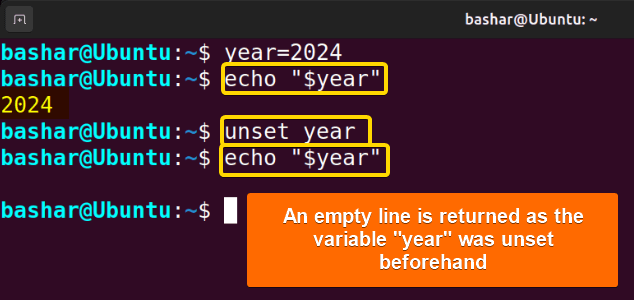The unset command is a built-in command in Linux that is used to unset values and attributes of shell variables and functions. It is useful for unsetting variables or functions if they are no longer required.
In this article, I’ll demonstrate the most common applications of the unset command in Linux with some practical examples.
Syntax of “unset” Command
The syntax of the unset command in Linux is:
unset [-f] [-v] [-n] [name ...]Note: Everything inside square brackets is optional in this syntax. Three dots after the name indicate that multiple values can be passed to the argument.
Options of “unset” Command
You can use the unset command without any options. In that case, the unset command first tries to unset a variable, and if that fails, then it tries to unset a function.
To check out all the available options, you can browse the help page for set command:
help setIn the help page, the listed unset command options are:
| Options | Description |
|---|---|
| -f | Treats each NAME as a shell function |
| -v | Treats each NAME as a shell variable |
| -n | Treats each NAME as a name reference and unsets the variable itself rather than the variable it references |
2 Examples of Using the “unset” Command in Linux
Let’s explore how you can use the unset command to unset the variables or functions:
1. Removing Shell Variables
To unset the shell variables, you can use the unset command with or without the option -v, the result will be the same. To unset the shell variables, first, open the Ubuntu Terminal and then set the variables. For example:
year=2024After setting values for the variable, check it:
echo "$year"Now to unset the variable, use the unset command:
unset yearFinally, check the variable again:
echo "$year"In the image above, you can see, an empty line is returned as the variable “year” was unset earlier.
2. Removing Functions
To unset the shell functions, you can use the unset command with or without the option -f. The distinction is that if you use the unset command without any options, it will first try to unset a variable, and if that fails, it will attempt to unset a function. However, if you use the unset command with the option -f, it will attempt to unset a function in the first place. Let’s open the nano window and write a function first:
nano greetings.shInside the nano window, you can define the functions in a script like this:
#!/bin/bash
#Defining the function
welcome_note() {
echo "Welcome!"
}
#Calling the function
echo "The function is called for the first time:"
welcome_note
#Unsetting the function
unset -f welcome_note
echo "The function is unset"
#Calling the function after unsetting it
echo "The function is called after unsetting it:"
welcome_noteIn this script named “greetings.sh”, I’ve defined the welcome_note function and called it once. Then, after unsetting the function, I attempted to call the welcome_note function again.
Now execute the script “greetings”:
./greetings.shFrom the image, you can see, the welcome_note function works properly the first time, returning the string “Welcome!”. However, an error message appeared when attempting to call the welcome_note function again after unsetting it.
Conclusion
In this article, I’ve demonstrated the unset command in Linux through some practical examples. The unset command, as the name suggests, is useful to unset the variables and functions. Try out the unset command and its options yourself. Hopefully, this article will help you in utilizing the unset command.
People Also Ask
What are set and unset in Linux?
The set and unset commands are two built-in commands in Linux. You can use the set command to set or unset the values of shell options and positional parameters. And, the unset command unsets the shell variables and functions.
How do you unset a function in Linux?
To unset a function in Linux, you can use the unset command with the option -f followed by the function’s name. This will remove the function from the current shell environment.
How do I unset a variable in Bash?
To unset a variable in Linux, you can use the unset command followed by the variable’s name. This will remove the variable from the current shell environment.
How to unset a variable using the set command?
To unset a variable using the set command, you can use the set command with the option -n.
FUNDAMENTALS A Complete Guide for Beginners


